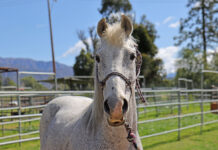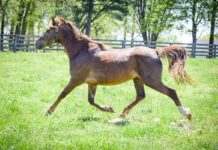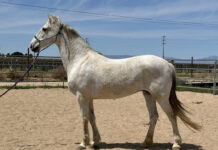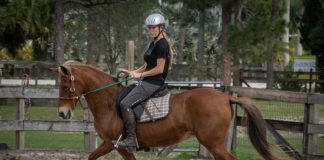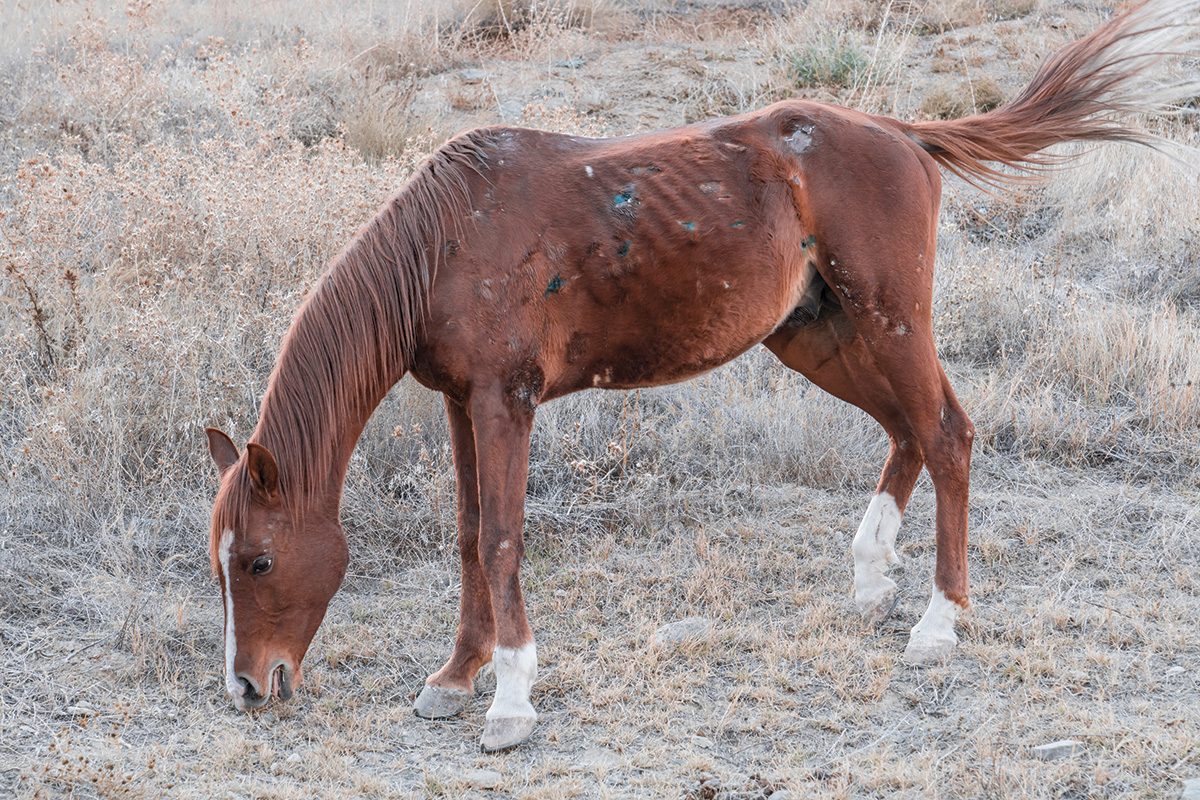
Three or four pinto horses nickered to us hopefully as we trudged up to the sagging wire fence, pulled on protective boots and ducked between the wires. The small group stood in a huddle on a steep muck pile, silhouetted against the morning sky, and a large herd of at least 60 stood quietly within the same large pen. On a regular day, I would have chuckled at the horses on the manure pile and snapped a few pictures, but today I kept my phone in my pocket.
Depths of Despair
Several horses limped past me, some coughing miserably with mucus draining freely from their noses and dripping abscesses under their jaws. Many other horses in the group were displaying identical symptoms. We snapped photos, took videos, pointed in astonishment, crouched down to study deformed and painful legs, and often just halted and stared in dismay.
This was one of the worst situations that I’d ever seen. The herd was a perfect showcase of every type of injury or illness that make veterinarians shake in their boots.
The horses that didn’t display huge painful joints, crooked legs, deformed feet, loud coughs, dripping abscesses, or labored breathing were starved beyond measure, every rib and vertebra prominent under taut skin. Horses stumbled away from us on feet so overgrown that their toes curled into the air. There were missing eyes, torn ears, and severe scars.
Every Assortment of Horses
I tried to categorize the medical problems, but I kept losing count, distracted by the never-ending parade of terrible injuries. There were nervous yearlings, pregnant and nursing mares with scraggly foals huddled against their sides, gentle adults with old saddle marks on their backs and severe swellings around their ankles, and sweet geriatric horses with swaybacks and shaky front legs.
There were angry little donkeys, Miniature Horses, and fine-boned ponies. There were draft crosses, Thoroughbreds, Quarter Horses, Morgans and Hackneys. And I couldn’t find one that was healthy.
Large horse trailers were lined along the dirt road leading to the property; the investigator whistled loudly and waved the first into position. The driver backed carefully up to the gate of the pen, and the sheriff’s department loaded the mares and foals first. Soon the trailer was pulling away and the second was backing in.
Taken Away
Load by load, the horses were removed. Soon there was nothing left but open gates, hoofprints and sagging fence wires shaking in the wind. I leaned against a fence post and rubbed my forehead. The horses were going to a safe ranch where they’d receive an identification number and get weighed. I would perform exams and assess their quality of life. They’d be fed and watered properly, maybe for the first time in a long time.
I was going to do everything in my power to help them, but based on what I’d seen, I knew that a significant number probably weren’t going to make it. I said a silent prayer for the horses and walked sadly to my truck.
As I drove to the ranch, I thought about the pasty glue marks on the horse’s backs and sides and the wrinkled and torn paper tags displaying large black numbers and bar codes, stuck firmly to their tails, hips and withers. These horses had endured multiple sales and had finally ended up at the kill pen.
When owners kick the can down the road by sending their old and lame horses to a sale rather than putting them to sleep, the horses linger miserably on the lots, frightened in the strange environment. They are bullied by other horses. They are “no-saled” again and again until the meat buyers come along. Then they are cleverly marketed to would-be rescuers.
The rescuers arrive, hooked by the sad stories, and pay a large amount of money to the gleeful kill buyers, who promptly replace departed horses with similarly crippled ones bought in batches for pennies on the dollar. And as often happens, the rescuers run out of money and energy and the horses end up in even worse situations.
Saying Goodbye
As I drove, I realized that I had a headache from clenching my jaw. I took some ibuprofen, washing it down with lukewarm coffee from my thermos.
Back at the ranch, we soothed the frightened animals, comforted the bewildered geriatrics, and gave them soft mashes to eat. We separated out stallions, pregnant mares, and weanlings. The nursing mares and foals got their own pen.
We treated fevers, coughs, dehydration, puncture wounds, painful eyes, and painful joints and feet. We wiped mucus-filled noses and eyes and cleaned diarrhea-crusted tails and hindquarters. And we sadly separated out the horses that were beyond our help.
Usually, my favorite part at the end of a large intake was leaning on the fence and watching the horses settle in and enjoy their fresh green hay and clean white salt licks, but knowing what I had to do for this particular pen in the morning made it hard to breathe.
I imagined them in their former lives, with bright coats and shining eyes, back when they had owners and back when they were sound. I wondered if someone had loved them and how they’d feel if they understood what their faithful old horses had endured these last few months.
I stood by that fence for a long time, and I silently promised the horses that it would be a painless and gentle departure. If it was all I could do for them, I prayed that it would be enough.
This edition of Vet Adventures appeared in the October 2022 issue of Horse Illustrated magazine. Click here to subscribe!

